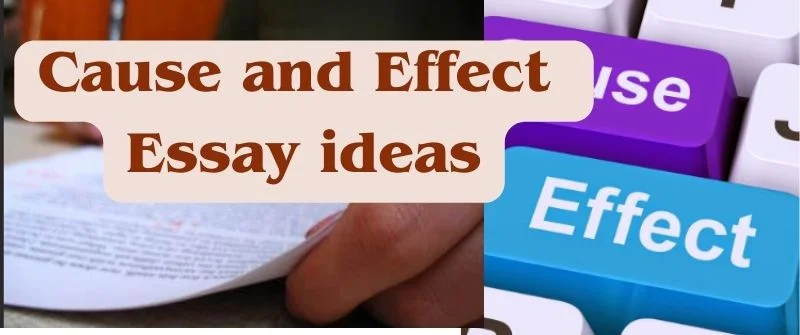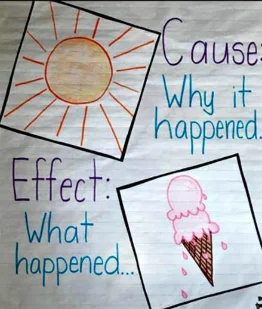Cause and Effect Essay ideas – 21 Examples of Cause and Effect Topics

Ever wondered about the intricate web of connections shaping our world? Join me on a journey into the heart of cause-and-effect essays.
These essays unravel the threads linking events and outcomes, providing insights into the why and how of our experiences.
We will explore 21 captivating cause-and-effect topics, offering a lens to understand the ripple effects that define our lives from societal shifts to personal choices.
Let’s dive into these narratives, examining the hidden forces that drive change and illuminate the intricate dance of causation in our everyday existence.
What is a Cause-and-Effect Essay?
A cause-and-effect essay explores the relationships between events or phenomena, aiming to uncover the reasons behind an occurrence and its subsequent impacts.

In this unique form of expository writing, the author delves into the “why” and “how” of a situation, examining the cause that triggers an effect or the effects that result from a particular cause.
The essay often follows a structured format, establishing a clear thesis that identifies the cause-and-effect relationship.
It then expounds on supporting evidence and examples, providing a comprehensive understanding of the interconnected elements.
Whether dissecting societal changes, environmental shifts, or personal experiences, cause-and-effect essays illuminate the intricate web of connections shaping our world, fostering a deeper comprehension of the forces at play in various scenarios.
How to Write a Cause and Effect Essay
1. Choose a Topic
When selecting a topic for your cause-and-effect essay, aim for relevance and depth. Choose an issue or phenomenon that intrigues you and has identifiable causes and effects.
Strive for a balance—avoid overly broad topics that lack focus and narrow subjects that limit exploration.
For example, explore the impact of social media on mental health, considering factors such as excessive screen time, cyberbullying, and the influence on self-esteem.
Mostly, this approach allows for a nuanced examination without overwhelming or limiting the scope of your analysis.
2. Develop a Thesis Statement
Crafting a precise and focused thesis statement is crucial for a successful cause-and-effect essay.
Clearly outline the cause-and-effect relationship you intend to analyze. For instance, a thesis could highlight the connection between increased social media usage (cause) and its detrimental impact on mental health (effect).
Such a structure ensures a roadmap for your essay. It guides readers through the specific cause-and-effect dynamics you will delve into while maintaining conciseness for clarity and impact.
3. Plan Your Essay
Planning is the foundation of a well-structured cause-and-effect essay. Outline the key points you intend to address, carefully considering both causes and effects.
Decide on the essay’s structure—whether you will emphasize causes and effects or present a balanced combination.
This preliminary roadmap helps organize your thoughts, ensuring a logical flow and coherence in your essay.
It is an essential step to provide readers with a clear and engaging exploration of the cause-and-effect relationship you’re examining.
4. Introduction
An impactful introduction is vital for a cause-and-effect essay. Start with a compelling hook to immediately engage your reader.

Introduce the chosen topic, offering relevant background information to set the stage. Apply the basics of the introduction paragraph in your essay.
Conclude your introduction with a concise yet powerful thesis statement, clearly outlining the cause-and-effect relationship you will delve into.
Doing so not only captivates your audience but also provides a roadmap for the insightful exploration that follows.
5. Body Paragraphs
In the body paragraphs, maintain a clear structure by dedicating each paragraph to a single cause or effect.
Support your points with compelling evidence, detailed examples, and relevant details. Employ effective transitions that smoothly guide your reader from one idea to the next to enhance the coherence of your essay.
Such measures ensure that each section of your essay is focused, well-supported, and seamlessly connected to the broader narrative.
5. Causes and Effects
Differentiate causes from effects in a clear manner within your essay. Delve into the intricacies of these relationships, providing insightful analysis on how each cause contributes to specific effects.
Illuminate the connections and dependencies between the identified causes and effects, offering your readers a comprehensive understanding of the causal chain you are exploring.
Typically, this analytical depth enhances the quality of your cause-and-effect essay, providing a nuanced perspective on the interplay between various elements.
6. Use Evidence
Substantiate your arguments with compelling evidence, be it statistical data, scholarly studies, or authoritative viewpoints.
Generally, this evidential support should precisely align with the cause-and-effect relationship under examination, reinforcing the validity of your claims.
After incorporating relevant and credible evidence, you bolster the persuasiveness of your essay, providing a solid foundation for your readers to grasp the intricacies of the causal connections you are elucidating.
7. Organize Chronologically or by Importance
Establish a coherent organization for your essay, opting for either chronological sequencing or an arrangement based on the significance of each cause or effect.
Such measures enhance the clarity of your narrative. They allow readers to seamlessly trace the progression of events or discern the relative importance of each element in the cause-and-effect chain.
A thoughtfully organized essay contributes to a more compelling and comprehensible exploration of the interconnected factors you are examining.
8. Conclusion
Craft a concise yet impactful conclusion that revisits the key points of your cause-and-effect essay without introducing novel information.

Reinforce the thesis statement, underscoring the importance of the cause-and-effect relationship you’ve explored.
Conclude with a thought-provoking statement that leaves a lasting impression on the reader, encouraging reflection on the broader implications of the discussed connections.
This approach ensures a strong and resonant finish to your essay, leaving readers with a lasting understanding of the presented cause-and-effect dynamics.
9. Revise and Edit
Prioritize the revision and editing phases to enhance the overall quality of your cause-and-effect essay.
Thoroughly review the content for clarity, coherence, and consistency, ensuring a seamless flow of ideas.
Pay close attention to grammar, punctuation, and spelling, rectifying any errors that may hinder comprehension.
To further refine your work, seek constructive feedback from peers or instructors, incorporating valuable insights to elevate the effectiveness of your cause-and-effect analysis.
Finally, this editing process adds polish and precision to your essay, ultimately contributing to its overall impact.
10. Finalize Your Essay
Finalizing your essay is a crucial step in the writing process. After receiving feedback, make the necessary revisions to enhance clarity and coherence.
Confirm that your essay adheres to formatting guidelines, including font, margins, and citation style.
Pay attention to details, addressing any remaining grammar, punctuation, or spelling errors. After reviewing and refining your essay, you ensure a polished and impactful final product.
11. Proofread
Proofreading is a vital step in perfecting your essay. Carefully review your work to catch any overlooked errors in grammar, punctuation, or spelling.
Pay attention to sentence structure and overall clarity. Reading your essay aloud can help identify areas that may need improvement.
After dedicating time to thorough proofreading, you ensure that your writing is polished and error-free, enhancing the overall quality of your essay.
12. Seek Feedback
Seeking feedback is an essential part of the writing process. Reach out to peers or instructors for constructive criticism and varied perspectives on your essay.
Their insights can uncover areas for improvement, helping you refine your cause-and-effect analysis. Be open to suggestions, and consider how their feedback aligns with your intended message.
This collaborative approach enhances the overall quality of your essay, ensuring it effectively communicates the cause-and-effect relationship to your audience.
13. Final Review
Before submitting your essay, conduct a final review to ensure it effectively communicates the cause-and-effect relationship.

Check for clarity, coherence, and consistency in your arguments. Confirm that your evidence supports your points, and review the overall flow of your essay.
Additionally, ensure adherence to formatting guidelines and eliminate any remaining grammar or spelling errors.
It ensures that your cause-and-effect essay is polished and ready for presentation, leaving a lasting impression on your readers.
14. Consider the Reader
When crafting your essay, consider the reader’s perspective to ensure accessibility for a general audience. Use clear and straightforward language, avoiding unnecessary jargon or complexity.
21 Examples of Cause and Effect Essay Topics for College
- The Effects of Exercise on Mental Health
- Causes and Consequences of Environmental Pollution
- The Influence of Parental Involvement on Academic Performance
- Effects of Technology Dependency on Human Communication
- Causes and Effects of Procrastination Among Students
- The Impact of Stress on Physical Health
- Consequences of Sleep Deprivation on Academic Success
- Causes and Effects of Climate Change
- The Influence of Fast Food on Obesity Rates
- Effects of Cyberbullying on Mental Well-being
- Causes and Consequences of Income Inequality
- The Impact of Video Games on Aggressive Behavior
- Causes and Effects of Substance Abuse Among College Students
- The Relationship Between Academic Pressure and Mental Health Issues
- Effects of Economic Recession on Employment Rates
- Causes and Consequences of Deforestation
- The Influence of Peer Pressure on Decision-making
- Effects of Social Isolation on Mental Health
- Causes and Effects of Gender Inequality in the Workplace
- The Impact of Technology on Work-Life Balance
- The Impact of Social Media on Interpersonal Relationships

Josh Jasen or JJ as we fondly call him, is a senior academic editor at Grade Bees in charge of the writing department. When not managing complex essays and academic writing tasks, Josh is busy advising students on how to pass assignments. In his spare time, he loves playing football or walking with his dog around the park.




